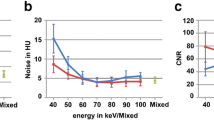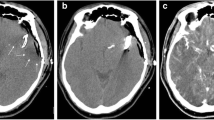Abstract
Purpose:
To assess the image quality of contrast-enhanced magnetic resonance angiography (CE-MRA) of the carotid artery with open 0.35-T magnetic resonance imaging (MRI), compared to a 1.5-T high-field system.
Patients and Methods:
100 patients were retrospectively evaluated with CE-MRA for suspected carotid or vertebral artery disease. 50 patients were investigated using an open-design 0.35-T MRI system, 50 were examined on a 1.5-T closed-bore magnet system. Maximum intensity (MIP) and volume-rendering technique (VRT) reconstructions were performed. Image quality was assessed using a four-point ranking score (1 = excellent, 4 = not evaluable). Signal-to-noise (S/N) ratio was measured. The data were analyzed using Wilcoxon's test (score data) and Student's t-test (S/N ratio). Significance levels were set at p < 0.05.
Results:
For 1.5-T imaging, average image quality using VRT for the common carotid artery (CCA), internal carotid artery (ICA), external carotid artery (ECA), and vertebral arteries (VAs) was 1.68, 1.14, 1.21, and 1.54, respectively. For MIP imaging, average image quality for the CCA, ICA, ECA, and VA was 1.44, 1.16, 1.22, and 1.22, respectively. For 0.35-T imaging, average image quality using VRT for the CCA, ICA, ECA, and VA was 1.46, 1.44, 1.90, and 2.02, respectively. For MIP imaging, average image quality for the CCA, ICA, ECA, and VA was 1.76, 1.80, 2.31, and 2.18, respectively. Quality differed significantly between 1.5 and 0.35 T, except for the CCA. There was no significant quality difference for the CCA between 0.35 T and 1.5 T using MIP or VRT reconstruction. There was no significant difference for the S/N ratio (p > 0.05).
Conclusion:
The 1.5-T system showed significantly or highly significantly better image quality scores, compared to the 0.35-T system. Nevertheless, image quality was rated satisfactory also using 0.35 T field strength.
Zusammenfassung
Ziel:
Untersuchung der technischen Machbarkeit und Evaluation der Bildqualität von kontrastverstärkten Magnetresonanzangiographien (CE-MRA) der extrakraniellen hirnversorgenden Gefäße an einem offenen 0,35-T-Magnetresonanztomographie-(MRT-)System im Vergleich zur konventionellen 1,5-T-MRT.
Patienten und Methodik:
100 Patienten wurden mittels CE-MRA zur Abklärung von Erkrankungen der Karotiden und der Wirbelarterien untersucht. 50 Patienten wurden an einem offenen Niederfeldsystem (0,35 T) untersucht, 50 an einem herkömmlichen geschlossenen 1,5-T-MRT-System. Es wurden MIP-(„maximum intensity projection“) sowie VRT-Rekonstruktionen („volume-rendering technique“) angefertigt. Die Bildqualität wurde anhand einer vierstufigen Skala analysiert (1 = exzellent, 4 = nicht bewertbar). Das Signal-Rausch-(S/N-)Verhältnis wurde gemessen. Die Daten wurden mittels Wilcoxon-Test (skaläre Daten) und Student-t-Test (S/N-Verhältnis) analysiert. Das Signifikanzniveau wurde bei p < 0,05 festgelegt.
Ergebnisse:
Bei 1,5 T lag die durchschnittliche Bildqualität unter Verwendung der VRT für A. carotis communis, A. carotis interna, A. carotis externa und Wirbelarterien bei 1,68, 1,14, 1,21 und 1,54. Bei Verwendung der MIP-Rekonstruktion betrugen die Werte 1,44, 1,16, 1,22 und 1,22. Bei 0,35 T lag die durchschnittliche Bildqualität unter Verwendung der VRT für A. carotis communis, A. carotis interna, A. carotis externa und Wirbelarterien bei 1,46, 1,44, 1,90 und 2,02. Bei Verwendung der MIP-Rekonstruktion betrugen die Werte 1,76, 1,80, 2,31 und 2,18. Der Unterschied zwischen Hochfeld- und Niederfeld-MRT war für alle Gefäße außer der A. carotis communis signifikant. Der Unterschied im S/N-Verhältnis war nicht signifikant (p > 0,05).
Schlussfolgerung:
Die Bildqualität der CE-MRA wurde für beide Systeme mit gut bis sehr gut bewertet. Das Hochfeldsystem zeigte signifikant bessere Werte für fast alle Halsgefäßabschnitte.
Similar content being viewed by others
Author information
Authors and Affiliations
Corresponding author
Rights and permissions
About this article
Cite this article
Klein, HM., Buchal, R., Achenbach, U. et al. Contrast-Enhanced MRA of Carotid and Vertebral Arteries. Clin Neuroradiol 18, 107–113 (2008). https://doi.org/10.1007/s00062-008-8012-x
Received:
Accepted:
Issue Date:
DOI: https://doi.org/10.1007/s00062-008-8012-x




